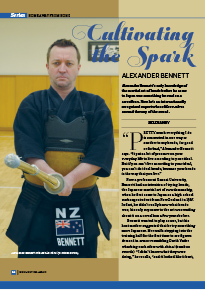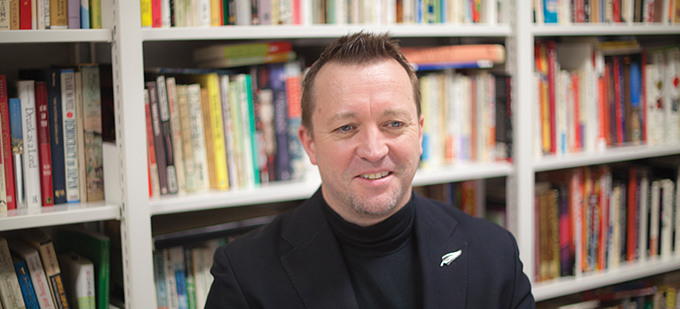Home > Highlighting JAPAN >Highlighting Japan October 2015>Home away from home
Highlighting JAPAN

Home away from home
Alexander Bennett
Cultivating the Spark
Alexander Bennett’s only knowledge of the martial art of kendo before he came to Japan was something he read on a cereal box. Now he’s an internationally recognized expert whose life revolves around the way of the sword.

“Pretty much everything I do is connected in one way or another to my kendo, for good or for bad,” Alexander Bennett says. “It puts a lot of pressure on your everyday life to live according to your ideal. But if you can’t live according to your ideal, you can’t do ideal kendo, because your kendo is the way that you live.”
Now a professor at Kansai University, Bennett had no intention of trying kendo, the Japanese martial art of swordsmanship, when he first came to Japan as a high school exchange student from New Zealand in 1987. In fact, he didn’t really know what kendo was; his only exposure to the art was reading about it on a cereal box a few years before.
Bennett wanted to play soccer, but his host mother suggested that he try something more Japanese. He recalls stepping into the training hall for the first time to see figures dressed in armor resembling Darth Vader whacking each other with shinai (bamboo swords). “I didn’t know what they were doing,” he recalls, “and it looked like it hurt, a lot. It’s quite vicious. I was actually afraid at first. But the mindset of the guy in charge, Sano-sensei, was that if you rock up, that’s it. It’s like the Eagles song ‘Hotel California.’ You can never leave.”
Despite that intimidating introduction, Bennett soon became hooked on kendo, studying not only the physical techniques required but its spiritual and philosophical underpinnings as well. After finishing up his year abroad and returning to Christchurch, New Zealand, he started the city’s first kendo club. He soon returned to Japan on a working holiday visa, followed by a stint studying martial arts at International Budo University in Chiba and a sponsorship from the Naginata Federation (naginata is a martial art using traditional Japanese polearms) that allowed him to work and train in the martial arts. Degrees in the Japanese language, culture and history followed. Twenty-five years passed in a blink. “Sometimes it doesn’t quite feel real,” he notes. “It feels like a dream that just keeps going on and on.”
Dr. Alexander Bennett is now one of the world’s top authorities on kendo. He holds a seventh dan (rank) in the art, is a member of the All Japan Kendo Federation’s International Committee as well as the director of the Japanese Academy of Budo and the head coach of New Zealand’s national kendo team. He’s also the editor-in-chief of the English-language magazine Kendo World, and holds two PhDs related to Japanese martial arts. His book Kendo: Culture of the Sword, published in July 2015, covers kendo’s history as well as its philosophical and cultural evolution.
Bennett’s next challenge is reaching eighth dan—the highest rank now possible in kendo. Kendo practitioners must wait ten years after achieving the seventh rank to even take the test. The minimum age is forty-six, and the success rate is less than one percent.
According to Bennett, a practitioner’s kendo evolves with age. “It becomes more minimalistic, more spiritual in a way,” he explains. “Obviously the physical side is very important, but as that sort of deteriorates, it is compensated for by an even stronger power, and that is your psychological power. So when I’m training with students, basically I am trying to overpower them with ki (spirit or life force).
“That’s the realm I’m trying to break into” he continues, “while also maintaining a beauty in form, but strength in spirit.” Reaching the eighth-dan level, however, is not his ultimate objective. “That’s just a milestone along the way. It’s more than the result itself; it’s the process. It’s working out how you can create your art, your kendo—that beauty and that strength.”
Bennett estimates there are around two million kendo practitioners worldwide, with 1.5 million of them in Japan. However, he says, kendo is growing rapidly internationally. And although kendo can be bewildering at first and you may have to put yourself through a lot of hardship, he says, “I think there comes a point where it’s all or nothing. You go through your whole life doing things halfheartedly, but when you’re in the kendo environment, if you do things halfheartedly, you might as well not be there, because it’s not much fun. When you actually take that leap and throw yourself into it, sacrifice yourself, commit yourself, there will come a time where something will spark in your mind.
“You just have to be an analogue human,” he concludes, “and get in touch with your emotions and your physicality and the strange bond between your mind and your body. So my advice is just keep going until one day you experience that spark.”
© 2009 Cabinet Office, Government of Japan






